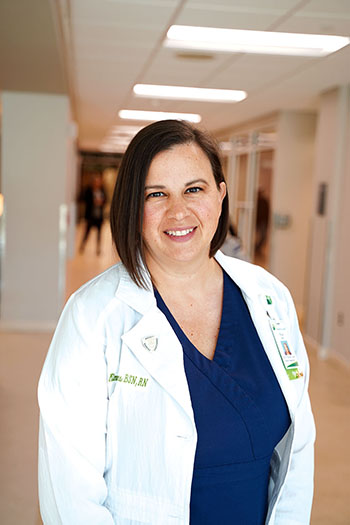Dedicated Team Gets You To The Right Bed The First Time
Kim Williams BSN, RN

Patient Placement Specialist Nurse
Centralized Patient Placement, St. Joseph’s/Candler
Smart Living: Patient placement is both intricate and fast-paced and was typically handled by a team of coordinators. But some hospitals, including St. Joseph’s Hospital and Candler Hospital, have created RN teams to assess and place patients. How does this change affect patient care?
Kim Williams: To put it simply, we get patients to the right bed the first time. We have a program called MD-Admit through which we receive requests for hospital beds from our admissions department, ED, regional hospitals, and multiple other places. We enter all the necessary pre-admit information and determine the next available appropriate bed based on placement requirements.
We also have bed huddles daily where every unit’s Clinical Nurse Manager or Resource Coordinator RN lets us know about discharges—or barriers to discharges—and internal patient flow. And of course the call center, Centralized Patient Placement, is a very busy place.
Within all of these moving parts, our sole focus is making sure people get admitted to the right place quickly. Although there are times when the hospital is full and that causes a wait for beds, our team—as well as the nurses and staff on the floor—is always working to have the next available bed ready for patients as soon as possible.
SL: What is the advantage in having RN’s in this role?
KW: Nurses can interpret vital signs, lab values, and other clinical information that helps us make decisions about where the patient should be. For example, a smaller regional hospital might have a patient in Intensive Care Unit, but based on the clinical data we collect, that patient could be perfectly fine in the Progressive Care Unit or even a floor bed here at St. Joseph’s/Candler. And those beds may be available sooner. The process is streamlined with us collecting the data and deciding who to call. We can use our nursing experience and critical thinking skills to expedite the entire process, so that the patient is not waiting on a bed.
SL: Do patients give feedback about their placement?
KW: Getting patients to the right bed ASAP is a process that happens behind the scenes, so we don’t really hear from patients but we do get great feedback from referring facilities. Because if they have a really sick patient or a mama who wants to deliver a baby and they don’t have the resources, it can be very frustrating for everyone. So with MD-Admit, even though I sometimes miss the bedside contact with a patient, I can help in ways I couldn’t before and that’s very gratifying.